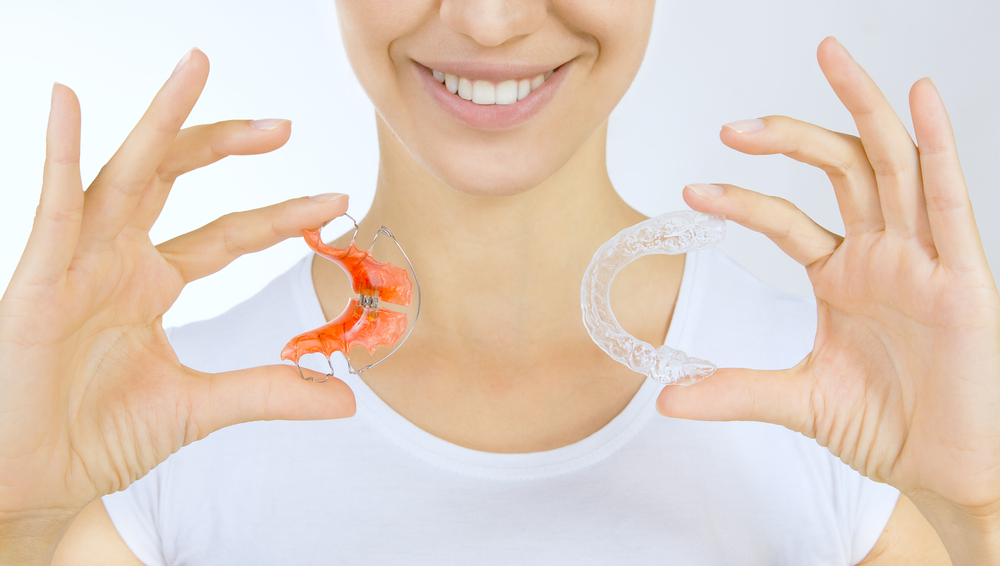
When you get your braces removed or take out your final Invisalign tray, it’s a big moment! As our Alaska, Monroe, Mill Creek, Bothell and Everett, WA Invisalign and braces patients will tell you, it’s exciting to see your final results. While it might seem like your orthodontic treatment is complete, there’s actually one more step and that’s wearing a retainer (or retainers). We promise, the outcome will be totally worth it. To help give you a better idea of what to expect, we’ll be covering why wearing a retainer is important and what the different types of retainers are.
Why Do I Have to Wear a Retainer After Braces or Invisalign?
There are two parts to your orthodontic treatment: the active phase and the retention phase. During the active phase, your braces or Invisalign aligners apply steady, gentle pressure to your teeth. The supporting bone that holds the teeth in place breaks down (don’t worry, this is painless!) in what’s known as bone remodeling. The teeth then shift to their new positions.
Once the pressure of your braces or Invisalign is taken away, the teeth have a natural tendency to want to move back to their old places. Wearing a retainer is the only way to hold your teeth where we want them while the tissue and bone rebuild to lock your smile into place. Depending on your needs, you may wear your retainer full time at first and then transition just to night before eventually wearing it a few nights per week. Other patients just need to wear it at night from the start. Additionally, there are natural changes that occur as we age that can cause the teeth to drift, which is another reason wearing a retainer is important.
Types of Retainers
Permanent Retainer – A permanent retainer, also called a lingual retainer, fixed retainer or bonded retainer, consists of a thin, metal wire that’s bonded to the back of your teeth on the tongue side. When you smile, it’s not visible at all. Once in place, it stays there indefinitely. You don’t really need to think much about it and once you get used to it, you won’t notice it’s there anymore. However, it can trap plaque, so oral hygiene will be important.
Hawley Retainer – A Hawley retainer is probably what comes to mind when you think of a retainer after braces. It features an acrylic piece that sits against the roof of the mouth and has a thin wire attached to it that wraps around your teeth. We can use it for both the upper and lower arch. A Hawley retainer is removable, so you’ll be able to take it out to eat and brush and floss your teeth and they’re comfortable. However, they can get lost and are easy to break, so you’ll have to be careful and store it in its retainer case. While Hawley retainers are a good option and we can even adjust them to make minor tooth corrections, more patients are choosing clear retainers instead since the Hawley retainer is visible when you smile, covers the roof of the mouth, and is less comfortable than the clear retainers.
Essix-Type Retainer – An Essix retainer, or clear retainer, is very similar to an Invisalign aligner. It’s made of medical-grade, BPA-free plastic and it’s removable. It goes over your teeth like a very comfortable mouthguard. A clear retainer like a Vivera® retainer, which is the Invisalign retainer made by the same company that makes the aligners, is virtually undetectable and comfortable. The material is a bit thicker than what your aligners are made from. While clear retainers are durable with proper care, they can crack and get misshapen if exposed to heat. As with any removable retainer, you’ll also want to be sure to use your retainer case so you don’t lose it.
Caring for Orthodontic Retainers
- If you have a permanent retainer, be sure to brush and floss diligently and clean around the wire to remove any plaque or food debris. An interproximal brush can be helpful for getting in the tight spaces. Store Hawley retainers and clear retainers in your retainer case whenever you take them out of your mouth. Pets love to chew on retainers and they’re easy to accidentally throw away. Never store your retainer in a hot car or expose it to really hot or boiling water. Clear retainers in particular can become warped and will have to be replaced.
- Take removable retainers out before eating or drinking anything except for plain water. With Invisalign retainers, any liquid or food can get trapped between the retainer and your teeth, which may increase your risk of tooth decay. Plus, drinking with a clear retainer in will cause it to stain.
- As for how to clean retainers, it’s simple! Brush your Hawley retainer or clear retainer with a soft-bristled toothbrush and rinse with lukewarm water. We would recommend skipping the toothpaste for clear retainers because it’s abrasive and can lead to visible scratches. Brush your retainer whenever you brush your teeth to prevent plaque from building up on it, which can cause it to smell. Patients often ask, can I use denture cleaner on retainers? Yes, you can. Every so often to give your retainer a deeper clean, you can use a product like Efferdent, or even a specialized retainer cleaner, such as Retainer Brite, to soak your retainers. For a DIY retainer cleaner, mix equal parts water and distilled white vinegar and soak your appliance for at least 15 minutes.
- If you forget to wear your retainer for a while, your teeth can be sore when you put it back in. The best way to avoid this is to just stick with your schedule and keep on wearing it until the discomfort subsides. If it’s been longer than a few nights and your retainer is really painful or doesn’t fit, give Richard Chan Orthodontics a call. Never try to adjust your Hawley retainer yourself as it can affect the fit and cause damage. Make an appointment and we’ll quickly get you back on track.
- Wondering what to do if you’ve lost your retainer? Call us right away! The longer you wait, the more your teeth can shift. We’ll create a replacement retainer for you so that you can maintain that straight smile.
There you have it, everything you need to know about the different types of retainers. If you have more questions about retainers or you’re ready to start treatment with Invisalign or braces in Everett, Monroe, Mill Creek, Bothell or Alaska, schedule a complimentary in-person or virtual consultation at Richard Chan Orthodontics today!
